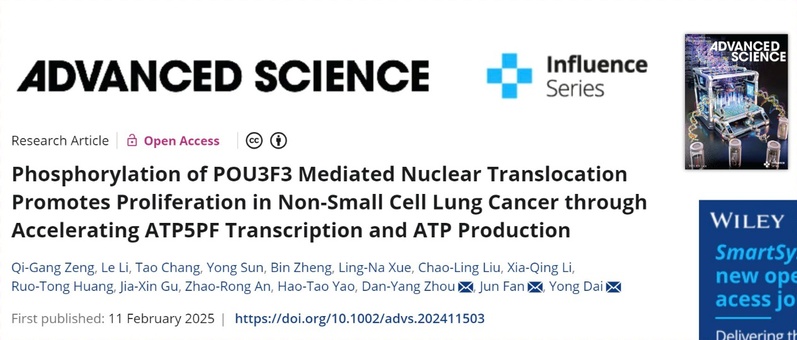- ABOUT JNU
- ADMISSION
-
ACADEMICS
- Schools and Colleges
-
Departments and Programs
- Arts College of
- Chinese Language and Culture College of
- Economics College of
- Electrical and Information Engineering College of
- Foreign Studies College of
- Information Science and Technology College of
- Environment School of
- Humanities School of
- International Business School
- International Studies School of
- Journalism and Communication College of
- Law School
- Liberal Arts College of
- Life Science and Technology College of
- Management School of
- Marxism School of
- Medicine School of
- Pharmacy College of
- Physical Education School of
- Science and Engineering College of
- Shenzhen Tourism College
- Research Institute
- Research Center
- Programs in English
- Majors
- Study Abroad
- Online Learning
- RESEARCH
- CAMPUS LIFE
- JOIN US
Research Unveils Mechanism by Which POU3F3 Promotes Non-Small Cell Lung Cancer Progression
Author: LI Le
Publisher: School of Medicine
Date: February 22, 2025
A collaborative research team led by Fan Jun from the School of Medicine at Jinan University, alongside Dai Yong from the School of Traditional Chinese Medicine and Zhou Danyang from the First Hospital of Nanjing City, has published groundbreaking findings in the esteemed journal Advanced Science (Impact Factor: 14.3). Their paper, titled Phosphorylation of POU3F3 Mediated Nuclear Translocation Promotes Proliferation in Non-Small Cell Lung Cancer through Accelerating ATP5PF Transcription and ATP Production, explores the molecular mechanisms by which the overexpression of octamer-binding protein 3 (POU3F3) enhances ATP production in non-small cell lung cancer (NSCLC) cells, thereby driving cancer progression.

(Screenshot of the paper)
The study highlights the promising potential of targeting oxidative phosphorylation (OXPHOS) by inhibiting the electron transport chain (ETC) in cancer therapies. While aerobic glycolysis is commonly associated with cancer, recent evidence suggests that enhanced OXPHOS provides significant metabolic advantages for cell proliferation, metastasis, and drug resistance in aggressive cancers, including NSCLC.
Key findings reveal that POU3F3 is translocated into the nuclei of NSCLC cell lines with mutant RAS, where it activates the transcription of ATP5PF, an essential component of mitochondrial ATP synthase. This mechanism leads to increased ATP production, which facilitates NSCLC proliferation and migration. Furthermore, the study identifies that ERK1 phosphorylates POU3F3 at the S393 site in the cytoplasm, promoting its nuclear translocation via importin β1 in RAS-mutant NSCLC cells.
The researchers conducted RNA sequencing and chromatin immunoprecipitation (ChIP) assays, demonstrating that POU3F3 binds to the promoter of ATP5PF, resulting in enhanced transcription and ATP production. Overall, this study uncovers a novel RAS-POU3F3-ATP5PF signaling axis that plays a critical role in NSCLC progression, providing fresh insights into the molecular mechanisms involved.
Li Le, Zeng Qigang, Chang Tao, Sun Yong, and Zheng Bin from Jinan University are the first authors of this paper, while corresponding authors include Fan Jun, Dai Yong, and Zhou Danyang from the First Hospital of Nanjing City.
For further details, read the full article here: Advanced Science
(https://advanced.onlinelibrary.wiley.com/doi/10.1002/advs.202411503).
NEWS
- About the University
- Quick Links
Copyright © 2016 Jinan University. All Rights Reserved.




